The global bacterial colony counters market is estimated to be valued at USD 464.8 Mn in 2025, and is expected to reach USD 628.8 Mn by 2032, exhibiting a compound annual growth rate (CAGR) of 4.4% from 2025 to 2032.
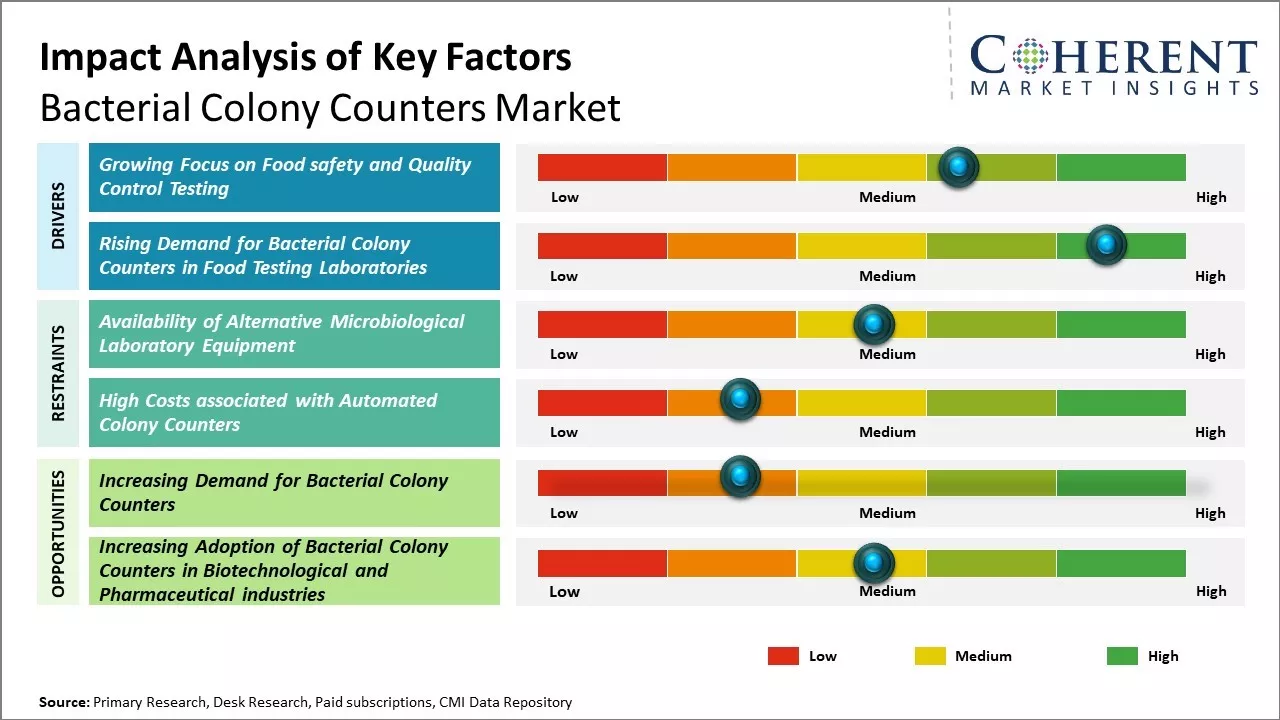
Discover market dynamics shaping the industry: Request sample copy
The bacterial colony counters market is witnessing positive growth owing to the increasing prevalence of infectious diseases along with growing use of bacterial testing and culture techniques. With advancements in technology, there is a growing demand for automated and digital colony counters that provide fast, reliable, and reproducible results. Manufacturers are focusing on the development of advanced devices equipped with artificial intelligence, internet of things, and connectivity capabilities to analyze bacterial growth patterns. This is helping researchers to respond more quickly and precisely to public health threats. Moreover, the integration of bacterial colony counters with laboratory information management systems (LIMS) is enabling improved workflow efficiency in clinical laboratories and research institutes. Favorable regulatory frameworks and funding for infectious disease research will further aid market growth over the forecast period.
Growing Focus on Food Safety and Quality Control Testing
With growing populations and concerns around public health, implementing stringent quality control procedures has become a necessity for food producers and suppliers worldwide. Bacterial colony counters provide an efficient and reliable way to test for harmful microbes in food and water sources. They automate the manual process of counting bacterial colonies, saving time and improving accuracy compared to traditional plate counting methods. With strict regulations and penalties in place across many countries regarding microbiological contamination in consumables, the demand for effective testing equipment has never been higher. Producers understand the need to detect even low levels of bacteria early on to ensure safe products reach consumers.
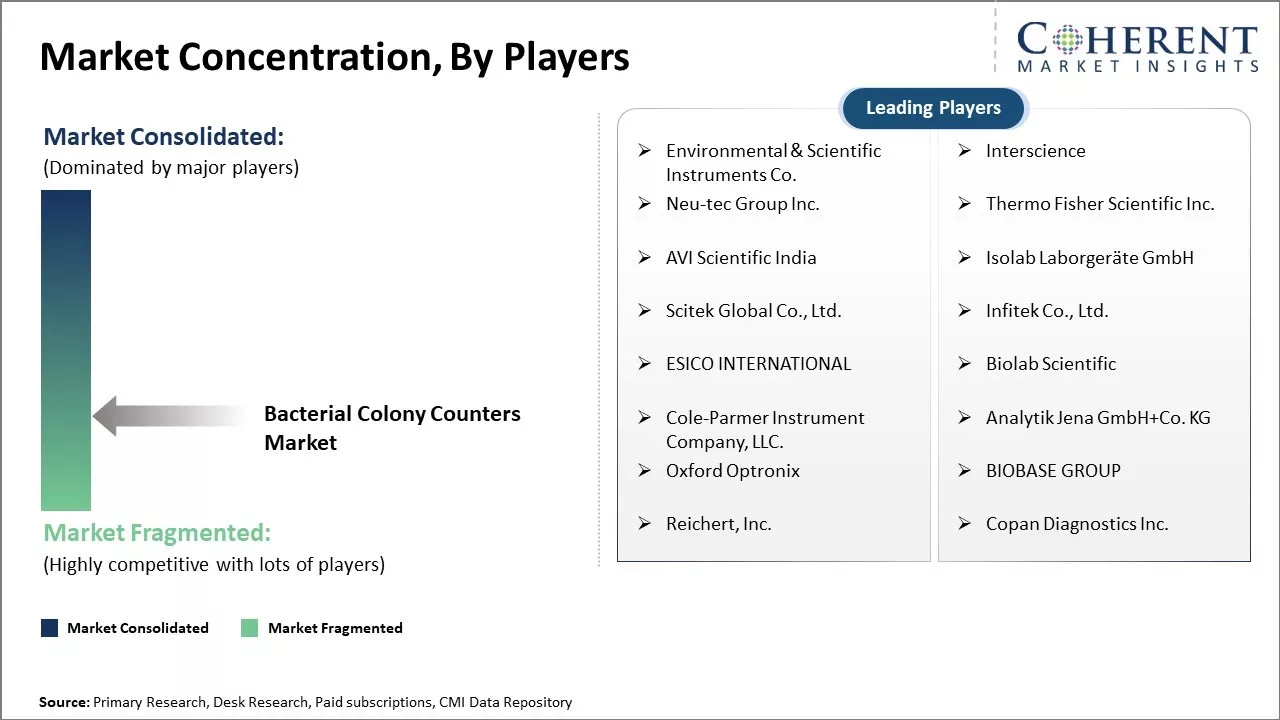
Get actionable strategies to beat competition: Request sample copy
Rising Demand for Bacterial Colony Counters in Food Testing LaboratoriesWith growing health concerns related to foodborne illnesses, food safety has become a top priority for food businesses and regulatory bodies. Stringent norms and standards are being implemented across the world to ensure the microbiological safety of various food products. This has led to higher testing volumes in food testing laboratories. Bacterial colony counting is a crucial test that is performed to determine the total viable bacterial count in a food sample. This helps detect contamination issues and ensure compliance with regulatory limits. Most food testing laboratories now rely on automated bacterial colony counters to process the large number of plates within short turnaround times. Manual counting of colonies is a laborious and time-consuming process that is also prone to errors. The automated colony counters can scan an entire Petri dish within minutes and provide accurate colony counts. This boosts efficiency and productivity significantly for labs. They are also able to count plates with crowded or touching colonies which is difficult through visual examination. The advanced imaging and recognition algorithms employed by modern colony counters make their use irreplaceable for high volume labs with strict reporting deadlines.
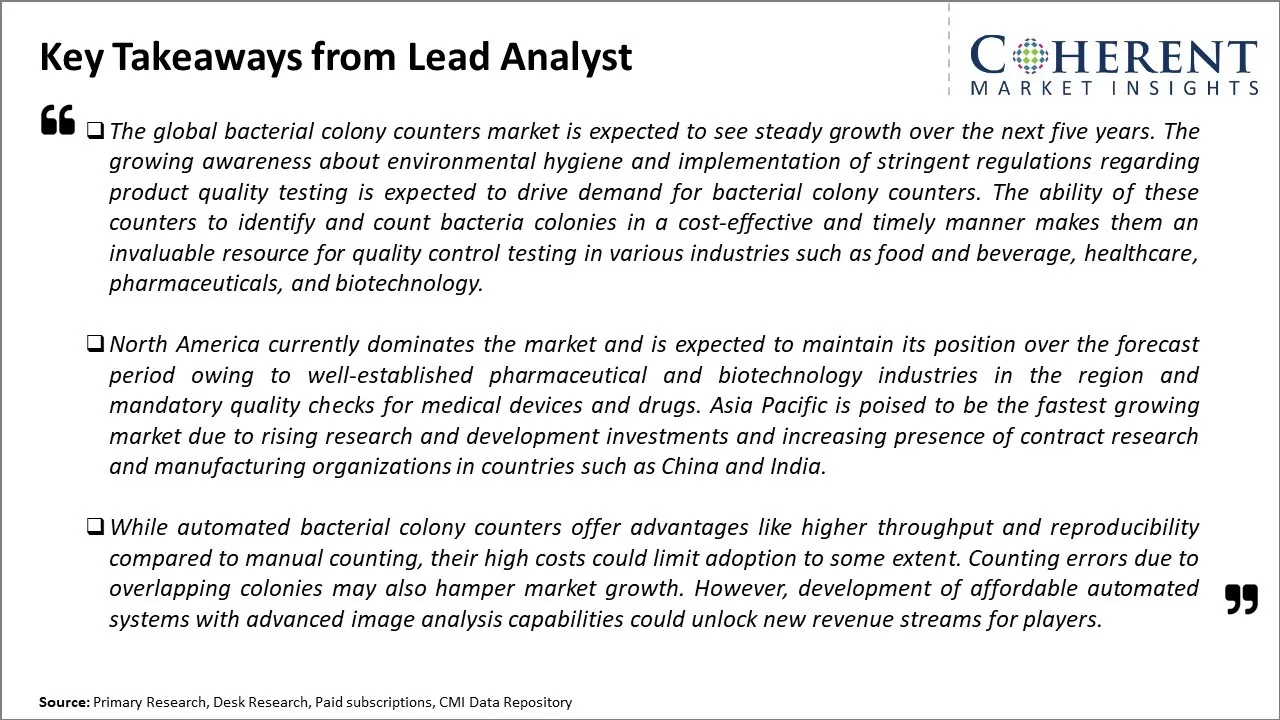
To learn more about this report, Request sample copy
Market Challenges – Availability of Alternative Microbiological Laboratory EquipmentOne of the key challenges for the global bacterial colony counters market is the availability of alternative microbiological laboratory equipment for performing bacterial enumeration. Technologies, such as flow cytometry and qPCR, provide easier and faster methods for counting bacteria compared to traditional colony counting techniques.
Market Opportunities – Increasing Demand for Bacterial Colony Counters
Strict microbiological testing regulations for food, water and environmental samples also require widespread adoption of colony counters. Furthermore, advancements in digital imaging, automated image analysis, and machine learning open up opportunities to develop more accurate and user-independent bacterial enumeration devices.
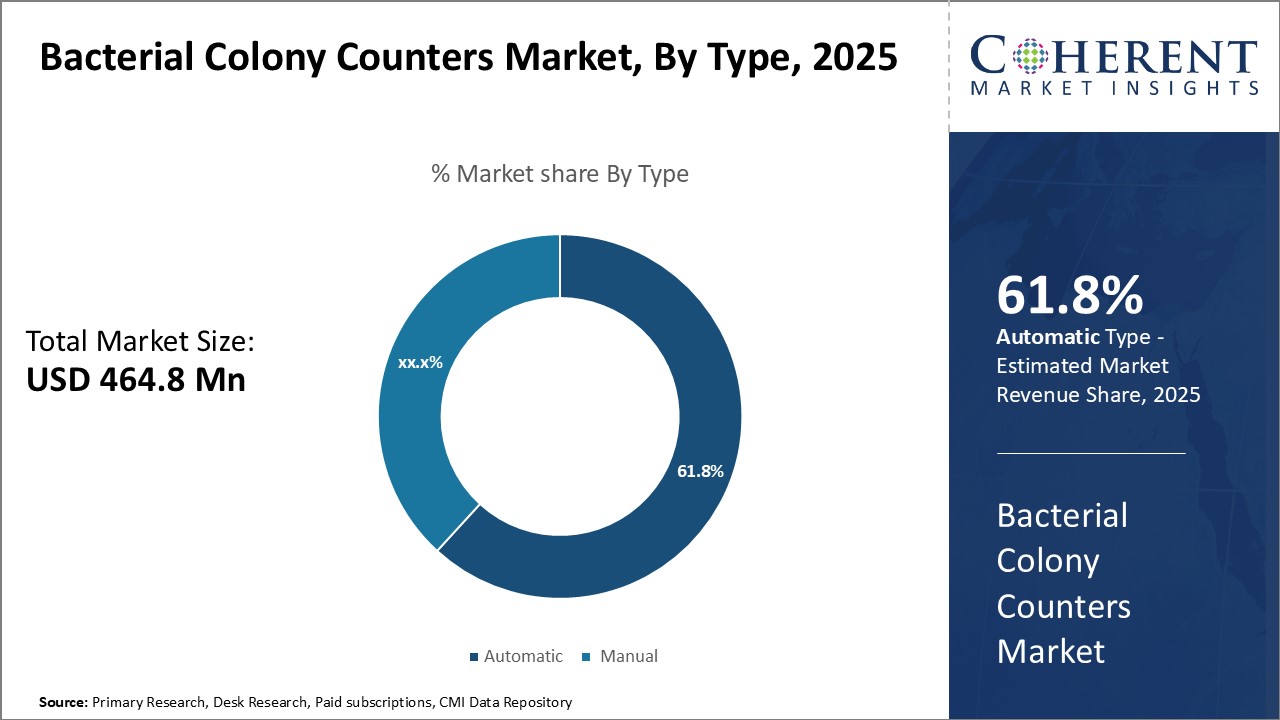
Discover high revenue pocket segments and roadmap to it: Request sample copy
Insights, By Type: Precision and AutomationThe type segment is sub-segmented into automatic and manual. The automatic segment is expected to hold 61.8% of the market share in 2025 owing to its precision and efficiency compared to manual counters. Automatic bacterial colony counters utilize advanced image analysis software that can scan agar plates, count the colonies present, and categorize them by attributes like size and color, and generate detailed reports. This level of precision and automation removes human errors and subjectivity from the counting process. With automatic systems, a single analyst can count multiple plates simultaneously and produce consistent results each time. Complex tasks like counting mixtures of colony morphologies across large numbers of plates can be handled with ease. The automated workflow improves lab productivity drastically by streamlining the counting task. Medical and pharmaceutical industries where bacterial testing is critical demand highly accurate and reproducible quantification of colony forming units (CFU), which only automatic systems can provide robustly. For these facilities, upgrade to automatic counters from older manual methods translates to higher output at lower costs.
Insights, By Application: Widespread Use of Bacterial Culture Testing Across the Healthcare Industry
The application segment is sub-segmented into medical, testing instruments, and others. The medical segment is expected to hold 46.2% of the market share in 2025, due to the widespread use of bacterial culture testing across the healthcare industry. Clinical microbiology laboratories in hospitals routinely conduct qualitative and quantitative bacterial cultures of patient samples to identify pathogens and determine appropriate treatment. Counting colonies from inoculated agar plates is an essential step in the analysis.
Insights, By End User: Stringent Regulatory Requirements
The end user segment is sub-segmented into pharmaceutical and biotechnology companies, clinical laboratories, and others. The pharmaceutical and biotechnology companies segment is expected to hold 57.7% of the market share in 2025 due to stringent regulations for microbiological testing. Microbial control and the monitoring of cleanroom environments are essential aspects of pharmaceutical manufacturing to ensure patient safety. Regulatory agencies such as the U.S. FDA have established guidelines mandating regular monitoring and reporting of microbiological levels in production facilities and their surrounding environments. Any detection of contamination could result in costly plant shutdowns and product recalls. Moreover, pharmaceutical products need to be tested at various stages of development and manufacturing to validate sterile conditions and ensure the absence of microbial growth. Automatic colony counters allow for faster and more reliable enumeration of bacteria in quality control samples compared to manual counting. They eliminate human errors and variations during the testing process. The use of automated colony counters enables pharmaceutical companies to adhere to regulatory protocols more efficiently. Their high performance and reproducibility are particularly important for applications involving sterile drugs and life science research. The need for documentation and data integrity further drives the adoption of automated counting solutions in this industry.
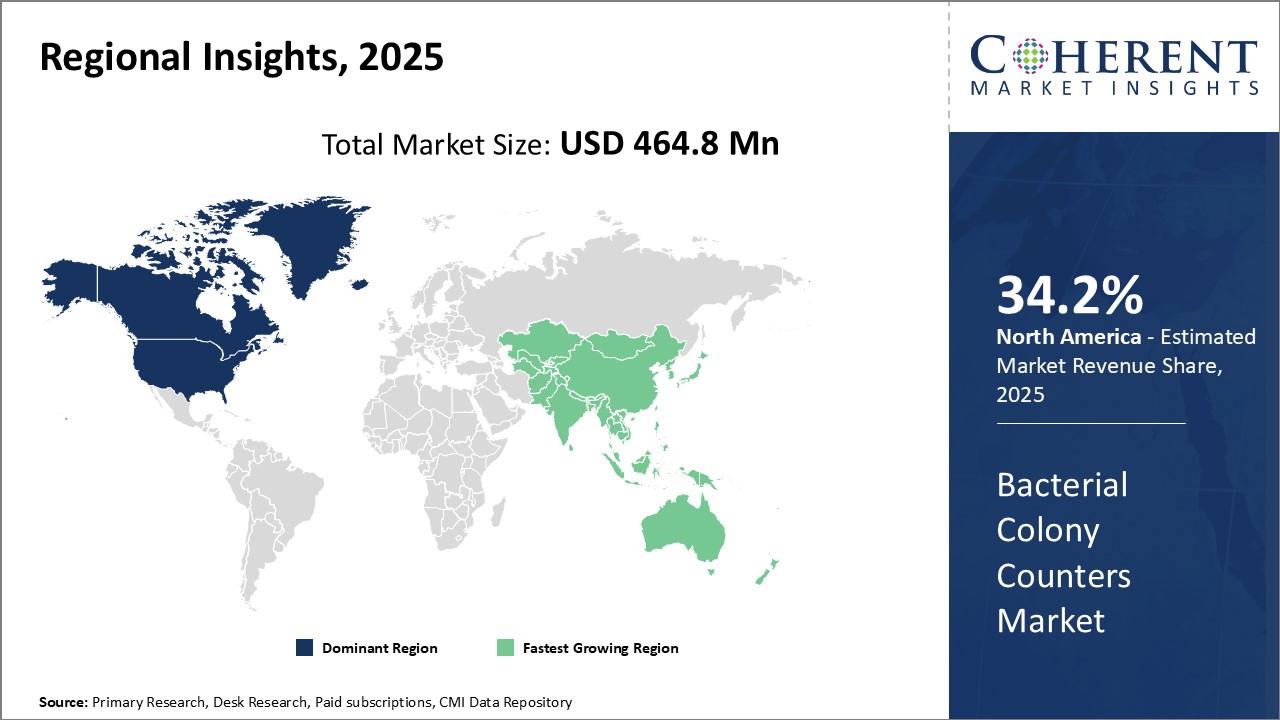
Need a Different Region or Segment? Customize now
North America remains the dominant region in the global bacterial colony counters market and is anticipated to hold 34.2% of the market share in 2025. The presence of top medical device companies and strong infrastructure for healthcare research and development have propelled the region to the forefront. Countries like the U.S. have advanced healthcare facilities and a large patient pool undergoing various diagnostic tests. This has ensured the constant demand for accurate and automated tools for bacterial colony counting. With favorable government policies supporting medical innovation and adoption of new technologies, the North America market provides lucrative opportunities for innovators. Large hospitals and diagnostic labs in the region are rapidly automating their microbial testing procedures. This has driven the procurement of digital colony counters for obtaining rapid and reproducible results. Furthermore, the region has a culture of rigorous quality control in pharmaceutical and food processing industries. The need for bacterial contamination monitoring contributes towards the regional market dominance.
The Asia Pacific region has emerged as the fastest growing regional market for bacterial colony counters. Countries like China, India, Japan, and South Korea are witnessing considerable economic development and expansion of their healthcare sectors. Rising affluence has improved access to advanced diagnostic technologies. Additionally, the large population size provides a scaling platform for manufacturers. Awareness about food safety and environmental monitoring is increasing in Asia Pacific. This stimulates the demand from industries such as dairy, beverage, and water treatment. Their need for reliable bacterial testing will continue propelling the regional market in future. The local production of low-cost colony counters by Asian companies further aids market penetration. A favorable investment environment and supportive policies indicate that Asia Pacific will play a crucial role in the global market dynamics.
Bacterial Colony Counters Market Report Coverage
| Report Coverage | Details | ||
|---|---|---|---|
| Base Year: | 2024 | Market Size in 2025: | USD 464.8 Mn |
| Historical Data for: | 2020 To 2024 | Forecast Period: | 2025 To 2032 |
| Forecast Period 2025 to 2032 CAGR: | 4.4% | 2032 Value Projection: | USD 628.8 Mn |
| Geographies covered: |
|
||
| Segments covered: |
|
||
| Companies covered: |
Environmental & Scientific Instruments Co., Interscience, Neu-tec Group Inc., Thermo Fisher Scientific Inc., AVI Scientific India, Isolab Laborgeräte GmbH, Scitek Global Co., Ltd., Infitek Co., Ltd., ESICO INTERNATIONAL, Biolab Scientific, Cole-Parmer Instrument Company, LLC., Analytik Jena GmbH+Co. KG, Oxford Optronix, BIOBASE GROUP, Reichert, Inc., and Copan Diagnostics Inc. |
||
| Growth Drivers: |
|
||
| Restraints & Challenges: |
|
||
Uncover macros and micros vetted on 75+ parameters: Get instant access to report
*Definition: Bacterial colony counter is a device used to count the number of bacterial colonies present in samples. The counters automate the manual process of counting bacterial colonies growing in petri dishes and provide faster results. They utilize image capturing and analysis software to count and measure colony sizes growing on agar plates in laboratories. Their digitization helps produce more consistent, accurate, and reliable colony counts compared to manual counting methods.
Share
Share
About Author
Komal Dighe is a Management Consultant with over 8 years of experience in market research and consulting. She excels in managing and delivering high-quality insights and solutions in Health-tech Consulting reports. Her expertise encompasses conducting both primary and secondary research, effectively addressing client requirements, and excelling in market estimation and forecast. Her comprehensive approach ensures that clients receive thorough and accurate analyses, enabling them to make informed decisions and capitalize on market opportunities.
Missing comfort of reading report in your local language? Find your preferred language :
Transform your Strategy with Exclusive Trending Reports :
Frequently Asked Questions
Joining thousands of companies around the world committed to making the Excellent Business Solutions.
View All Our Clients
US Reciprocal Tax Impact Analysis On Bacterial Colony Counters Market
Stay updated on tariff changes with expert insights and timely information